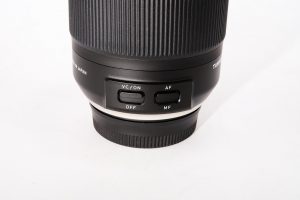No Products in the Cart
 If you're still using the kit lens that has made all those good images, it is likely to be an 18-55 type with a similar maximum aperture of 3.5-5.6 0r 6.3. Maybe it has an image stabilisation system in it, or maybe it doesn't, but you'll not have noticed all that much difference in the shots one way or the other. The really important thing is that the Tamron big zoom has so much of what you are already used to that you do not need to retrain yourself in what to do.
So - what do you get that you don't have already? You get the ability to zoom into and isolate parts of the world that have heretofore disappeared into the general pattern. You get to see clearly and precisely more of the distant details of the world. And you get to fiddle with image compression and framing in a way that you have never had before. Part of that is exciting and part of that is disturbing.
I am not suggesting that you go and spy on military barracks or nurse's showers with the long part of the lens. If you'd a mind to do that you'd do it anyway until they beat the heck out of you. But now you can take the long part of the lens to surfing carnivals, airshows, wildlife parks, and all sorts of places and bring back the pictures that count. You can isolate brides and portrait sitters in a soft and hazy field of drreams...even at smaller f stops. You can compress perspective to make the mountains, buildings, or crowds loom up behind your main subject - without making that subject uncomfortable.
And the great part is that you still have the wide-angle view that makes the landscape shot so impressive - or opens out a crowd in an interior. It won't need a lens change with all the attendant dust and juggling, and you won't have to haul a bag of lenses on holiday. You might even have fun while getting good shots. A radical suggestion, I realise, but worth thinking about.
If you're still using the kit lens that has made all those good images, it is likely to be an 18-55 type with a similar maximum aperture of 3.5-5.6 0r 6.3. Maybe it has an image stabilisation system in it, or maybe it doesn't, but you'll not have noticed all that much difference in the shots one way or the other. The really important thing is that the Tamron big zoom has so much of what you are already used to that you do not need to retrain yourself in what to do.
So - what do you get that you don't have already? You get the ability to zoom into and isolate parts of the world that have heretofore disappeared into the general pattern. You get to see clearly and precisely more of the distant details of the world. And you get to fiddle with image compression and framing in a way that you have never had before. Part of that is exciting and part of that is disturbing.
I am not suggesting that you go and spy on military barracks or nurse's showers with the long part of the lens. If you'd a mind to do that you'd do it anyway until they beat the heck out of you. But now you can take the long part of the lens to surfing carnivals, airshows, wildlife parks, and all sorts of places and bring back the pictures that count. You can isolate brides and portrait sitters in a soft and hazy field of drreams...even at smaller f stops. You can compress perspective to make the mountains, buildings, or crowds loom up behind your main subject - without making that subject uncomfortable.
And the great part is that you still have the wide-angle view that makes the landscape shot so impressive - or opens out a crowd in an interior. It won't need a lens change with all the attendant dust and juggling, and you won't have to haul a bag of lenses on holiday. You might even have fun while getting good shots. A radical suggestion, I realise, but worth thinking about.
 The barrel on a Tamron is now made to a professional standard and the glass has always been good. It is value for money, and for the person who wants to move forward from a kit lens, it is a very good choice. The person who is currently making a living with, winning photo competitions with, and perfectly happy with their kit lens can cheerfully go make a cup of tea, but should remember this column nevertheless - they might just want to go look at bears in British Columbia one day and they are better seen at 400mm than 55mm...or through the crosshairs of a Weaver scope.
Trust me on this one.
The barrel on a Tamron is now made to a professional standard and the glass has always been good. It is value for money, and for the person who wants to move forward from a kit lens, it is a very good choice. The person who is currently making a living with, winning photo competitions with, and perfectly happy with their kit lens can cheerfully go make a cup of tea, but should remember this column nevertheless - they might just want to go look at bears in British Columbia one day and they are better seen at 400mm than 55mm...or through the crosshairs of a Weaver scope.
Trust me on this one.